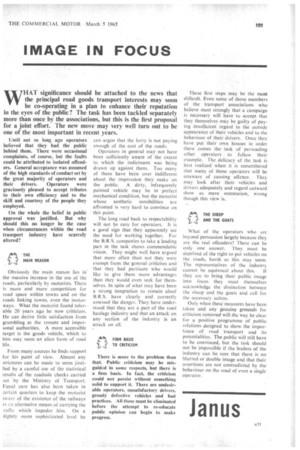IMAGE IN FOCUS
Page 105

If you've noticed an error in this article please click here to report it so we can fix it.
WHAT significance should be attached to the news that the principal road goods transport interests may soon be co-operating in a plan to enhance their reputation in the eyes of the public? The task has been tackled separately more than once by the associations, but this is the first proposal for a joint effort. The new move may very well turn out to be one of the most important in recent years.
Until not so long ago operators believed that they had the public behind them. There were occasional complaints, of course, but the faults could be attributed to isolated offenders. General acceptance was assumed of the high standards of conduct set by the great majority of operators and their drivers. Operators were graciously pleased to accept tributes to their own efficiency and to the skill and courtesy of the people they employed.
On the whole the belief in public approval was justified. But why should this no longer be the case when circumstances within the road transport industry have scarcely altered?
THE MAIN REASON Obviously the main reason lies in the massive increase in the use of the roads, particularly by motorists. There is more and more competition for road space within towns and on the roads linking towns, even the motorways. What the motorist found tolerable 20 years ago he now criticizes. He can derive little satisfaction from grumbling at the remote and impersonal authorities. A more accessible target is the goods vehicle, which to him may seem an alien form of road life.
From many sources he finds support for his point of view. Almost any strictures can be made to seem justified by a careful use of the statistical results of the roadside checks carried put by the Ministry of Transport. Equal care has also been taken in zertain quarters to keep the motorist iware of the existence of the railways is en alternative means of carrying the :raffle which impedes him. On a ;lightly more sophisticated level he can argue that the lorry is not paying enough of the cost of the roads.
Operators in general may not have been sufficiently aware of the extent to which the indictment was being drawn up against them. Too many of them have been over indifferent about, the impression they make on the public. . A dirty, infrequently painted vehicle may. he in perfect mechanical condition, but the motorist whose aesthetic sensibilities are affronted is very hard to convince on this point. .
The long road back to respectability will not be easy for operators. It is a good sign that they apparently see the need for working together. For the B.R.S. companies to take a leading part in the task shows commendable vision. They might well have argued that more often than not they were exempt from the general criticism and that they had partisans who would like to give them more advantages than they would even seek for themselves. In spite of what may have been a strong temptation to remain aloof B.R.S. have clearly and correctly assessed the danger. They have understood that they are a part of the road haulage industry and that an attack on any section of the industry is an attack on all.
FIRM BASIS TO CRITICISM
There is more to the problem than that. Public criticism may be misguided in some respects, but there is a firm basis. In fact, the criticism could not persist without something solid to support it. There are undesirable operators, Unsatisfactory drivers, grossly defective vehicles and bad practices. All these must be eliminated before the attempt to re-educate public opinion can begin to make progress. These first steps may be the most difficult. Even some of those members of the transport associations who believe most strongly that a campaign is necessary will have to accept that they themselves may be guilty of paying insufficient regard to the outside appearance of their vehicles and to the behaviour of their drivers. Once they have put their own houses in order there comes the task of persuading other operators to follow their example. The delicacy of the task is best realized when it is remembered that many of those operators will be unaware of causing offence. They may look after their vehicles and drivers adequately and regard outward show as mere ostentation, wrong though this view is.
nTHE SHEEP AND THE GOATS What of the operators who are beyond persuasion largely because they are the real offenders? There can be only one answer. They must be deprived of the right to put vehicles on the roads, harsh as this may seem. The representatives of the industry
cannot be equivocal about this. It they are to bring their public image into focus they must themselves acknowledge the distinction between the sheep and the goats and call for the necessary action.
Only when these measures have been taken and any genuine grounds for criticism removed will the way be clear for a positive programme of public relations designed to show the importance of road transport and its potentialities. The public will still have to be convinced, but the task should not be impossible if the leaders of the industry can be sure that there is no blurred or double image and that their assertions are not contradicted by the behaviour on the road of even a single operator.
Janus




























































































































































